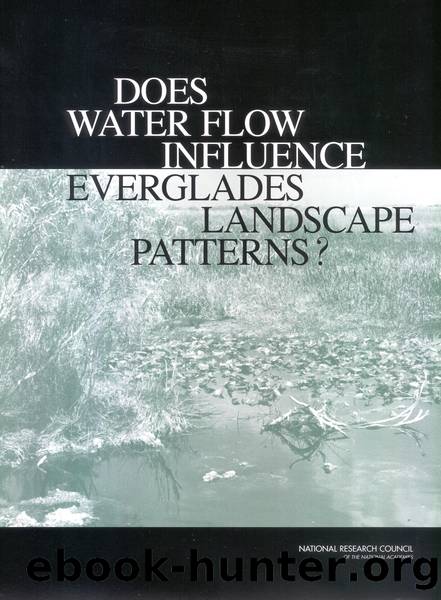DOES WATER FLOW INFLUENCE EVERGLADES LANDSCAPE PATTERNS? by National Research Council of the National Academies

Author:National Research Council of the National Academies
Language: eng
Format: epub
Tags: Earth Sciences: Water and Hydrology
Publisher: NATIONAL ACADEMY PRESS
Published: 2003-12-31T00:00:00+00:00
4 Conclusions and Recommendations
The current understanding of the effects of flow on wetland ecosystems and the origin and maintenance of the ridge and slough landscape is well summarized in the recently published Science Coordination Team White Paper (SCT, 2003). The ecological importance of the topographic structure in this landscape is well documented, as is the degradation of that structure in many areas, particularly in association with major linear structures that inhibit flow. The development and use of performance measures that quantify changes through time in the geometry of ridges, sloughs, and tree islands, as proposed in the White Paper, are well justified. Performance measures that incorporate remote sensing are attractive because they are relatively inexpensive yet provide integrated information about the ecosystem condition. However, since considerable flattening of the landscape may occur before degradation is detectable by remote sensing, a network of transects to monitor microtopographic changes is also a high priority.
Several plausible mechanisms for the formation and maintenance of the ridge and slough landscape have been proposed, and some involve flow, but none have been investigated in detail. Evidence of the importance of flow is circumstantial rather than based on support for a particular mechanism. Nonetheless, despite the scant quantitative data, the circumstantial evidence is strong that direction, velocity, and rate of flow (i.e., discharge) have important effects on the parallel ridges, sloughs, and tree islands in the central Everglades. Ignoring flow introduces an important source of uncertainty in the implementation of the Restoration Plan.
Alternative mechanisms can be evaluated to some extent from readily accomplished work such as analysis of underlying bedrock topography, detailed surface topographic mapping and measuring accumulation of organic sediment. Nonetheless, more extensive, focused research will also be necessary. Most of the essential elements of such a research program are described in the White Paper. Immediate attention should be given to the development of alternative conceptual models of the formation and maintenance of the ridge and slough landscape, and the most compelling models should be used to develop research hypotheses and questions that can be used to guide the design of a research program. Paired comparisons between relatively intact landscapes and degraded ones may be particularly informative.
As noted in the White Paper, the conditions responsible for the development of the ridge and slough landscape may be different from those responsible for its maintenance. Research on maintenance of the landscape has a more direct impact on restoration, and should have higher priority than research on the original conditions governing its formation (see Box 2-1). The White Paperâs recommendation to conduct a comprehensive multidisciplinary study of the paleoenvironmental history of the ridge and slough landscape is justified in this regard.
Because it is not clear whether the ridge and slough landscape is maintained by average or extreme conditions, it is important that monitoring be designed to provide integrated measurements of flow and sediment transport for the full range of flow conditions, especially including extreme events. This will be challenging and expensive, and measurement sites should be co-located with sites where other related research on the ridge and slough landscape is occurring.
Download
This site does not store any files on its server. We only index and link to content provided by other sites. Please contact the content providers to delete copyright contents if any and email us, we'll remove relevant links or contents immediately.
| Automotive | Engineering |
| Transportation |
Whiskies Galore by Ian Buxton(41726)
Introduction to Aircraft Design (Cambridge Aerospace Series) by John P. Fielding(33022)
Small Unmanned Fixed-wing Aircraft Design by Andrew J. Keane Andras Sobester James P. Scanlan & András Sóbester & James P. Scanlan(32693)
Craft Beer for the Homebrewer by Michael Agnew(18087)
Turbulence by E. J. Noyes(7902)
The Complete Stick Figure Physics Tutorials by Allen Sarah(7273)
Kaplan MCAT General Chemistry Review by Kaplan(6831)
The Thirst by Nesbo Jo(6770)
Bad Blood by John Carreyrou(6483)
Modelling of Convective Heat and Mass Transfer in Rotating Flows by Igor V. Shevchuk(6359)
Learning SQL by Alan Beaulieu(6169)
Weapons of Math Destruction by Cathy O'Neil(6090)
Man-made Catastrophes and Risk Information Concealment by Dmitry Chernov & Didier Sornette(5883)
Digital Minimalism by Cal Newport;(5593)
Life 3.0: Being Human in the Age of Artificial Intelligence by Tegmark Max(5410)
iGen by Jean M. Twenge(5334)
Secrets of Antigravity Propulsion: Tesla, UFOs, and Classified Aerospace Technology by Ph.D. Paul A. Laviolette(5245)
Design of Trajectory Optimization Approach for Space Maneuver Vehicle Skip Entry Problems by Runqi Chai & Al Savvaris & Antonios Tsourdos & Senchun Chai(4962)
Electronic Devices & Circuits by Jacob Millman & Christos C. Halkias(4871)
